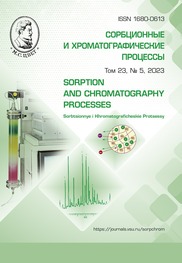Sorption of humus and its distribution in the profile of chernozems depending on the granulometric composition
Abstract
Particle-size composition is a fundamental characteristic that has a significant impact on many properties and regimes of soils, including sorption and fixation of humus by elementary soil particles (ESP). The main role in increasing the humus content of soils belongs to ESP with sizes <0.01 mm.
We examined the structural features of humus profiles of leached chernozems formed on soil-forming rocks of different granulometric compositions. For this purpose, a large sample of data on the quantitative content of humus in chernozems of different granulometric compositions was analysed.
The goal of the research was to identify the dependence of humus sorption on the granulometric composition of chernozems, and also to reveal the features of the profile distribution of humus in them.
Objectives: conduct field research of chernozems of different granulometric composition; select soil samples and conduct a series of laboratory studies of these samples for the identification of the sorption properties of ESP in relation to humus; identify the features of humus distribution in soils of different granulometric compositions.
It has been shown that with an increase in the granulometric composition of the content of ESP related to physical clay (<0.01 mm), the sorption capacity of the soil for humus increased. Thus, from sandy loam (ESP <0.01 mm=14-20%) to clayey varieties (ESP <0.01 mm = 61-64%) of chernozems, the humus content increased, respectively, from 3.88 to 7.09%. The thickness of the humus layer increased in the same direction from 22 to 100 cm. Therefore, soils of different granulometric compositions have their own structural features of the organoprofile, consisting in the nature of the humus distribution.
Downloads
References
Ahtyrcev B.P., Ahtyrcev A.B. Poch-vennyj pokrov Srednerusskogo CHerno-zem'ya. M., Nauka, 1993; 222. (In Russ.)
SHein E.V. Kurs fiziki pochv. M., MGU, 2005; 432. (In Russ.)
Piccolo A., Mbagwu J.S.C. Effects of different organic waste amendments of soil microaggregates stability and molecule sizes of humic substances. Plant Soil. 1990; 123: 27-37.
Blair G.J., Lefroy R.D.B., Singh B.P., Till A.R. Development and use of a carbon management index to monitor changes in soil C pool size and turnover rate. Driven by nature: Plant litter quality and decom-position. 1997; 273-282.
Tarchitzky J., Hatcher P.G., Chen J. Properties and distribution of humic sub-stances and inorganic structure stabilizing components in particle-size fractions of cultivated Mediterranean soils. Soil Sci. 2000; 165: 328-342.
Laird D.A., Martens D.A., Kingery W.L. Nature of clayhumic complexes in an agricultural soil: chemical, biochemical and spectroscopic analysis. Soil Sci. Soc. Amer. J. 2001; 65(5): 1413-1418.
Chefetz B., Tarchitzcy J., Deshmukh A.P. Structural characterization of humic acids in particle-size fraction an agricultur-al soil. Soil Sci. Soc. Am. J. 2002; 66(1): 129-141.
Arthur E., de Jonge L.W., Tuller M., Moldrup P. Clay content and mineralogy, organic carbon and cation exchange capac-ity affect water vapour sorption hysteresis of soil. European Journal of Soil Science. 2020; 71(2): 204-214. https://doi.org/10.1111/ejss.12853
Olayemi O.P., Wallenstein M.D., Kallenbach C.M. Distribution of soil organ-ic matter fractions are altered with soil priming. Soil Biology and Biochemistry. 2022; 164: 108494. https://doi.org/10.1016/j.soilbio.2021.108494
Startsev V.V., Khaydapova D.D., Degteva S.V., Dymov A.A. Soils on the southern border of the cryolithozone of Eu-ropean part of Russia (the Subpolar Urals) and their soil organic matter fractions and rheological behavior. Geoderma. 2020; 361. https://doi.org/10.1016/j.geoderma.2019.114006
Kleber M., Sollins P., Sutton R. A conceptual model of organo_mineral in-teractions in soils: self-assembly of organic molecules fragments into zonal structures on mineral surfaces. Biogeochemistry. 2007; 85: 9-24.
Feng X., Simpson A.J., Simp-son M.J. Chemical and mineralogical con-trols on humic acid sorption to clay mineral surfaces. Organic Geochemistry. 2005; 36: 1553-1566.
Ghosh S., Wang Z.Y., Kang S., Bhowmik P.C., Xing B.S. Sorption and fractionation of a peat derived humic acid by kaolinite, montmorillonite, and goethite. Pedosphere. 2009; 19(1): 21-30.
Simpson A.J., Simpson M.J. Nuclear magnetic resonance analysis of natural organic matter. Biophysicochemical processes involving natural nonliving or-ganic matter in environmental systems. John Wiley & Sons. 2009; 876.
Zolovkina D.F., Karavanova E.I., Stepanov A.A. Sorption of water-soluble organic substances by mineral hori-zons of podzol. Eurasian Soil Science. 2018; 51(10): 1154-1163. https://doi.org/10.1134/S1064229318100162
Milanovskii E.Yu., Shein E.V. Functional role of amphiphilic humus components in humus structure formation and soil genesis. Eurasian Soil Science. 2002; 10(35): 1064-1075.
Semyonov V.M., Kogut B.M. Pochvennoe organicheskoe veshchestvo. M. GEOS, 2015; 233. (In Russ.)
Klassifikaciya i diagnostika pochv SSSR. M., Kolos, 1977; 221. (In Russ.)
World reference base for soil resources 2014. International soil classifi-cation Schulten H.R., Leinweber P. New insights into organic–mineral particles: composition, properties and models of mo-lecular structure. Biology Fertility Soils. 2000; 30: 399-432.







